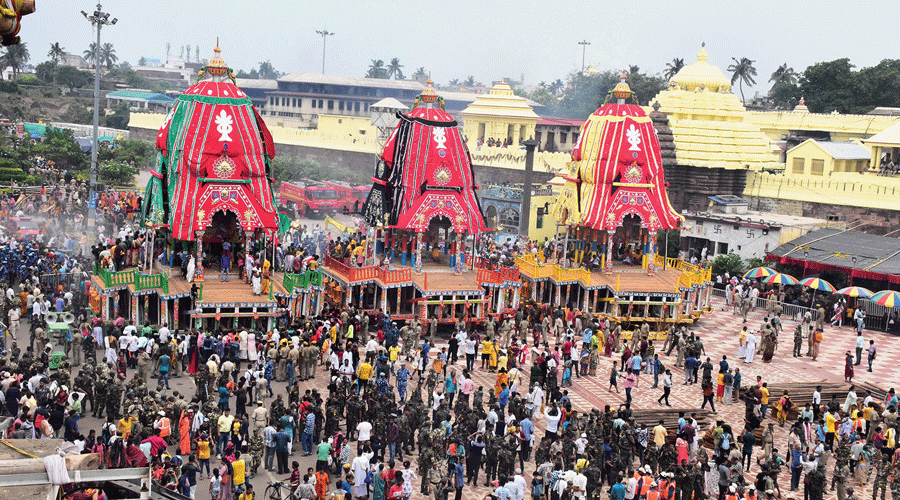The three chariots — Taladhwaja, Nandighosh and Darpadalan — are ready to roll on the Grand Road (Bada Danda) of Puri on Friday.
The 2.5km boulevard stretches from the 12th century Shree Jagannath Temple to the Shree Gundicha Temple. Lord Jagannath and the siblings will step out of their abode and embark on a nine-day sojourn on the three chariots pulled by lakhs of devotees, marking the beginning of the Rath Yatra. The chariots, decorated in keeping with tradition, are under strict surveillance of thousands of police and intelligence officials.
Chief carpenter of Nandighosh, Bijay Mohapatra, spoke to The Telegraph about the labour that goes into fashioning the chariots, their weight and height. “No modern equipment is used for measurement. We never use any tape for the purpose. We just use a 20 inch stick (considered as a scale) and a rope for measurement. Each of the giant chariots with 45 feet height are constructed with measures taken with this stick and rope. It’s all about how accurate your hands and the fingers are. There has never been any mistake. It’s knowledge that we have acquired over the generations. It’s because of the blessings of the Lords,” said Mohapatra.
Around 75 carpenters and 80 artisans are engaged for the construction of the chariots. Nearly 10,800 cubic feets of wood comprising 2,188 pieces are used to build the three chariots. While 832 pieces of wood are used to build 45.6 feet Nandighosh Rath of Lord Jagannath (chariot with 16 wheels, each of seven feet in diameter, and four gateways), 763 pieces of wood used for Lord Balabhadra’s 45ft Taladhwaja rath with 14 wheels, each of six feet in diameter, and four gateways and 593 pieces to build Goddess Subhadra’s 44.6ft Darpadalan chariot with 12 wheels, each of six feet in diameter, and four gateways.
Mohapatra said even the iron nails that are used for construction of the chariots are made by the blacksmiths attached to the Shree Jagananth Temple for centuries. “Nearly 36 kinds of servitors adept in different trades are involved in making of the chariots and rituals involved in the Jagannath temple. It takes around 58 days to build the three chariots,” Mohapatra said.
“The collection of wood to build the giant chariots begins after Puri King issues orders for the construction of the chariots It starts from the third day of Vaisakh month on the auspicious day of Akshay Tritiya. Earlier Puri King used to give the wood but now the state government arranges the wood each year. The construction of chariots goes on for 58 days. Even the colouring work of the chariots and their drapings are finished just a day ahead of the Rath Yatra every year without a single mistake,” said another carpenter, 72-year-old Narasingha Maharana.
Nearly 1,090 metres of cloth is used to cover the three chariots. While the Taladhwaja Rath of Balabhadra is draped with the red and green canopy, Lord Jagannath’s Nandighosh chariot is covered with the yellow and red, Goddess Subhadra’s chariot is decked with red and black cloth canopy. “Even we place a charioteer in each of the chariots. For Nandighosh, the charioteer is dressed in yellow holds reins of four white horses, green attired charioteer guiding four black horses is placed in for Balabhadra’s rath Taladhwaja and black attired charioteer guiding four maroon horses is placed in Subhadra’s chariot Darpadalan,” said another carpenter.
Such is the enthusiasm among the servitors for the chariot work that they keep aside their normal work to work for the making of chariots and other services attached to it. “We forget our normal work for two months, take leave from our employers to engage ourselves in chariot construction. It’s because of the Lord that we survive. It’s our first priority,” said Alok Bhoi, a servitor.
Yashobanta Maharana, a chartered accountant-cum-servitor, said, “This is our pride. I work in a chartered accountancy firm. We do our normal job for 10 months but during these two months we dedicate ourselves for the Lord’s work.”
Rajeswara Mohapatra had quit his graphic designing job to do his bit for the Rath Yatra. “I do this work so that we keep up our family tradition and my father feels proud of me,” said Mohapatra.
All the three chariots are attached with four pieces of coconut coir ropes, each of eight inches diameter and 250 metre long to enable the devotees to pull the chariots. “ Sometimes, we use another two ropes in case of any need. Earlier we used to bring the ropes from Kerala but now Odisha’s Coir Corporation is supplying the coir ropes,” said senior servitor and former chairman of the Odisha Coir Corporation, Ramkrushna Das Mohapatra.











